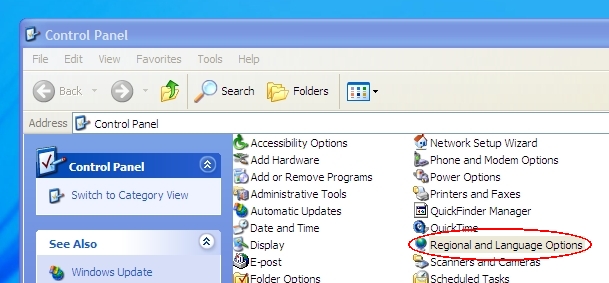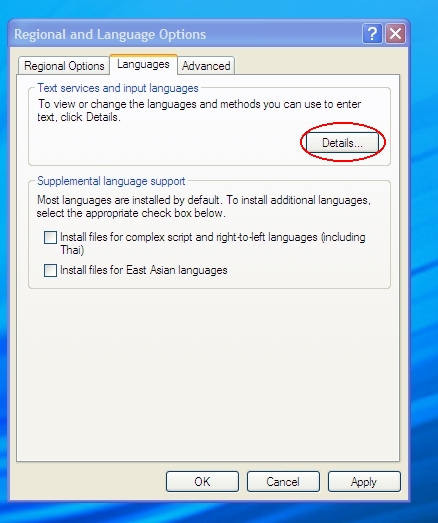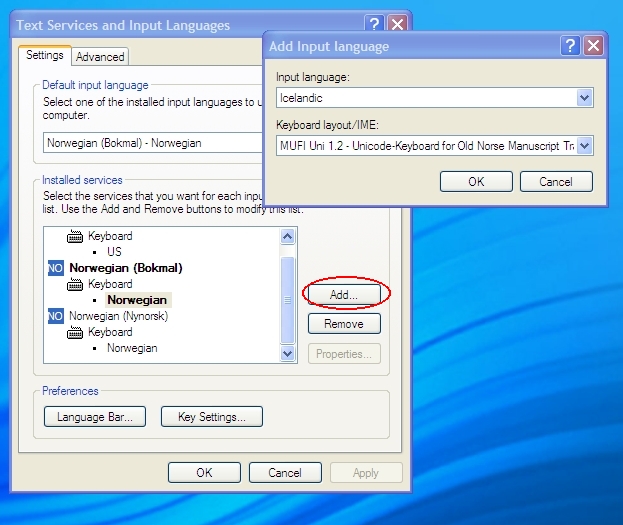Windows XP keyboard layout |
|
Disclaimer: This site is managed by scholars in Medieval studies with the aim of establishing a consensus on the use of Unicode among medievalists. It is not affiliated with or endorsed by Unicode. |
1. General
2. Requirements
3. Where are the characters located?
4. Redesigning the keyboard layout
5. Installation
6. Problems?
This package contains a specialized keyboard layout for transcribing Medieval Nordic texts on a Microsoft Windows 2000 or XP system. It does not include all characters in the MUFI recommendation, but a selection chosen with regard to frequency in actual manuscripts and consistency of the arrangement. The keyboard has been optimised for the transcribing of primary sources on the facsimile and the diplomatic level (cf. The Menota handbook ch. 3).
The layout is made as similar as possible to the equivalents on other systems, so that scholars transcribing on different platforms should not face too many difficulties.
The keyboard layout on this site has been developed with support from the project Menota TVB. It can be downloaded free of charge at each user's own risk.
The Windows keyboard will only work if you have:
a) a MUFI compatible font (like Alphabetum 6.0) installed, and
b) you are using an application that handles Unicode input properly (e.g. <oXygen/> and many other applications, e.g. Microsoft Word).
The layout has been designed on the basis of MUFI character recommendation version 1.0 (including the update by 16 March 2004).
For Windows OS, only one keyboard layout has been developed. This layout is intended to return actual characters on screen and in display, like any other keyboard. For Mac OS, an additional keyboard has been set up, "MUFI entites". This keyboard is made for SGML / XML encoding and returns entities, e.g. "á" when pressing ALT+a. A keyboard layout of this type is not possible (to the best of my knowledge) on Windows, since a key can only return a maximum of four characters. Almost all entities consist of more than four characters. For more details, please check the Mac OS X page.
Note that the files offered here are "work in progress" and any feedback from users would be greatly appreciated. Contact: Florian Grammel.
The mapping of the ordinary keys is identical to the standard US layout (note: the British one is the same except having "£" where the US has "$").
There are three exceptions:
1. There are three variants of the Tironean "et" sign: "&et;", "&ET;" (in comb. with SHIFT) and "&etslash;" (in comb. with ALTGr)
2. The keystroke for "`" will return the the frequently used abbreviation signs "&bar;" and "&barbl;"
3. instead of "\" you will find "&" and vice versa. This is to faciliate the input of these entities which are not directly accessible on the keyboard.
All other special characters are entered by a combination of either ALTGr, ALTGr + SHIFT, or CAPS LOCK and an ordinary character, which has some (hopefully obvious) mnemotechnical connection to the special character in question.
ALTGr + letter will return the most frequently used variant of the letter:
e.g. ALTGr + a gives "a" with an acute accent
e.g. ALTGr + s gives the long "s" character.
ALTGr + digit will return abbreviation marks that resemble the figure:
e.g. ALTGr + 1 gives the zig-zag abbreviation mark
e.g. ALTGr + 4 gives the "r" rotunda with a stroke across its tail
ALTGr + SHIFT + letter will return a superscript letter.
ALTGr + SHIFT + digit will return less usual variants of the abbreviations.
|
Plain |
ALTGr |
ALTGr + SHIFT |
|
Letter a, e, i, o, u, y, j, v, w r t s d f g k l x c n m |
Most frequently used variant of the letter characters with acute accent r rotunda thorn (***) long s eth insular f unical t (*) unical k (***) broken l unical d (*) closed unical f (*) n with long right leg unical m |
Combining superscript characters a superscript, e superscript, etc. |
Digit 1 2 3 4 5 8 9 |
Abbreviation marks &er; &ur2; &etfin; &rum; &ra; &ur8; &us; |
Variant abbreviation marks – – – – &rabar; &ur8open; &ussep; |
&et; (on US: §) |
et with slash |
– |
|
[ ] ; ' & (on US: \) |
ligature av ligature aa ligature oe ligature aa o with ogonek |
ligature au ligature ao o umlaut a umlaut e with ogonek |
|
, . / |
Combining diacritics combining ogonek (**) combining dot above (**) combining acute (**) |
Combining diacritics combining curl (**) combining dot below (**) combining grave (**) |
combining bar (on US: `) |
combining umlaut (**) |
combining dubble acute (**) |
(*) Since the most obvious key has already been used for more frequent characters, another key immediately below has been chosen.
(**) These characters will be placed above or below the preceding character. Thus, to produce "o with ogonek and acute", type ["o"] + [ALTGr + ","] + [ALTGr + "/"]. Do not forget that the layout is based on the US keyboard (thus, the slash, "/", is located in the rightmost position in the bottom line of keys).
(***) These characters are so called "dead keys", i.e. they can melt together with the following character to a ligature, e.g. "thorn" plus "s" to the ligature of "thorn and long s". If the single letters are needed, type: thorn, space, s.
|
Keystroke 1 |
Keystroke 2 (simultaneously) |
Result |
|
SHIFT |
a, b, c, d, e, f, ... |
uppercase letters (as in any other keyboard layout) |
|
CAPS LOCK |
a, b, c, d, e, f, ... |
small capitals |
|
Keystroke 1 |
Keystroke 2 (subsequently) |
Result |
|
ALTGr + = |
a, b, c, d, e, f, ... |
enlarged minuscules |
|
ALTGr + - |
f, g, r, v |
insular letter form |
Start by entering keystroke combination 1, depress this keystroke, then press keystroke 2. Remember that the layout is based on the US keyboard (thus, the equation sign, "=", is located in the rightmost position in the upmost line of keys, and the minus sign, "-", in the key immediately to the left).
Note that most characters have an enlarged minuscule letter form, but that only a minority has an Insular letter form ("f" is one of them).
If you are working with texts containing many other characters than those included in our layout, you may modify the layout yourself. For this purpose you can use our definition files (included in the download), which can be modified and compiled with The Microsoft Keyboard Layout Creator. This utility has also been used in the making of the present MUFI keyboard layout.
1. Download the zip archive containing the files needed here. Depending on the browser you use, you might have to unpack the archive manually by double-clicking it.
2. Double-click the Installer and follow the instructions. Do NOT throw away the installer files, as you will need them in case you want to deinstall the layout later!
3. Choose "Regional and Language Options" from the "Control Panel".

4. Click "Details" in "Languages" tab.

5. Choose "Add" in the "Installed Services" field.

6. In the box popping up, first choose a language that you do not use otherwise from the upper menu (e.g. "Icelandic", as shown in the screen shot). Then choose "MUFI Uni" from the second menu. (Unfortunately, MS Windows does not allow users to define layouts independently of languages, and it seems impossible to add a new language to the list provided. Therefore, the user has to assign the Medieval Nordic keyboard layout to an arbitrary language.)
7. Close all three windows by clicking "OK" in each.
8. Select your keyboard layout by selecting the language you have chosen in (6) from the menu in the task bar. Note that you can change layouts whenever you want. However, some applications do not yet support all keyboard layouts.

It is strongly recommended to have one's usual keyboard installed, too. You can easily shift from one layout to another by pressing Left ALT+ SHIFT. (Key sequences for particular layouts can be assigned in the "Language Bar..." preferences in the "Text Services and Input Languages" control panel.)
"MUFI chart.pdf" in the package can be printed for easy reference.
In general: When the layout does not work with a particular application: Try another application.
Other possible problems:
1. The handling of special fonts is not implemented equally well in all Unicode-savy applications. Unfortunately also <oXygen/> has some problems here, which Java is said to be responsible for.
2. Some applications use keystroke combinations with "ALTGr" for predefined shortcuts (unfortunately also the latest version of <oXygen/>), even though these ought to be reserved for keyboard layouts. These shortcuts can usually be disabled in the application itself, typically in the "Preferences" menu.
3. Check whether your system is fully Unicode enabled. This layout will not work with any system prior to Windows 2000.
4. Is your application fully Unicode enabled? If you are not sure, try the keyboard layout in a "safe" Unicode-savy application like "Notepad".
5. If it still does not work properly, repair the layout with the installer. Just start the installer as if you wanted to install in the first place and choose "repair" from the dialogue. Also deinstalling and reinstalling might help.
Created 10 December 2004. Last update 14 December 2004.